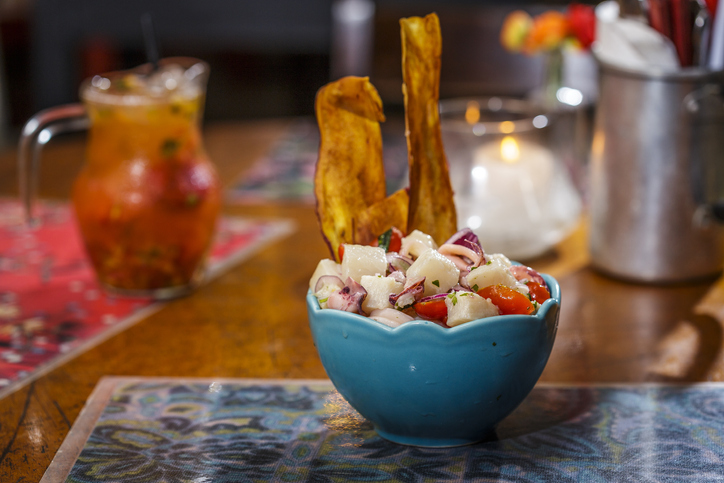Peru’s climate and geography have turned it into a culinary landscape full of contrasts, with flavours and dishes that are a selection of the diversity and history of each of its regions
with culinary nuances from every corner of the country, talking about the ‘taste of Peru’ means talking about fusion food, with flavours that nourish and pay homage to the motherland (or Pachamama, as they call it in Quechua).
Peru is a land with numerous raw materials that, for travellers who get to know a destination through their cuisine, this will lead you to discover a country where each one of its regions offers unique culinary experiences.
These culinary peculiarities are the result of unique gastronomic identities in a country that counts good food as one of its riches—Peru has now been named Best Culinary Destination in the World for seven years in a row at the World Travel Awards.
Arequipa and picanterías
Arequipa lies in the southern part of Peru, and is a city where the tradition of picanterías (restaurants specialising in spicy food) lives on through the daily life of the ‘picanteras’—women who have inherited cooking skills from their mothers and grandmothers and who run kitchens full of humility and flavour in equal measure. In the past, people used these restaurants to drink ‘chicha’, a beverage made with fermented corn, and used to quench their thirst when eating spicy food. That’s where the restaurants got their name, from the Spanish word for spicy: picante.
In picanterías, neither time nor current trends are essential ingredients. Visiting a picanteria means going deep into Arequipa, at the dawn of Peruvian cooking, where most fusion cuisine has an added spicy kick. The restaurants offer menus with continuous odes to former times and original, traditional dishes, where chupe (shrimp soup with milk and cheese) and sopa blanca (soup with lamb, corn, chickpeas and potatoes) are served every day of the week.
Stuffed rocoto is one of the main dishes. Similar to red peppers, rocoto is a superfood that is rounder and much spicier. The rocoto stuffing is made of meat, cheese, eggs and olives, all coated with a second layer of melted cheese added just before they go in the oven.
Given all this culinary heritage, Arequipa hopes to be named a Creative City of Gastronomy by UNESCO in 2019, a decision that will be announced later this year.
Peruvian fish? Head to the North Coast
Tumbes, Piura, Lambayeque and La Libertad are regions that make up the North Coast, an area known for its warm climate. These regions lie close to the sea, which means that seafood is the main feature of its cuisine.
A trip to the North Coast invites you to savour a fish and seafood ceviche that, unlike in other places, is served with zarandaja (creamy beans) and yucas. One variant on the traditional ceviche recipe is chinguirito, which made with guitarfish meat that has been dried to accentuate the marine flavour. Majarisco is another variety from northern Peru, and it is made with mashed green banana and a variety of seafood: black ark clams, prawns, crab and squid with a touch of chicha de jora: Incan corn beer that is also used to dress duck rice and the majority of northern stews.
Cusco, a present full of the past and the future
In this Andean city nothing takes a label – fusion, tradition and the latest trends are all accepted. Although it has a traditional culinary background, the capital of Tahuantinsuyo has been the birthplace of a number of new suggestions for Peruvian cuisine over the years, from projects with a link to the Mediterranean, to Thai, Italian, and Nikkei fusion, and anything that can be made with a Peruvian flavour.
In Cusco, chefs like Gastón Acurio give the city its own unique flavour at Chicha, a restaurant that reinterprets traditional flavours. On the other hand, Virgilio Martínez at ‘MIL’ offers cuisine that supports the environment and local products.
Some of the restaurant’s more traditional dishes include cuy chactado, which is made with guinea pig meat marinated in chicha de jora, ground chilli pepper, peppermint and salt, then fried until the skin is crispy. Another famous dish is the Cusco-style pork marinade, an exquisite concentrated broth known as levanta muertos–which in Spanish means is it tasty enough to ‘raise the dead’! Cusco is also home to choclo con queso and humita caliente (corn paste wrapped in the cob leaves).
Get lost in the Peruvian jungle
The Amazon offers visitors exotic flavours that surprise the palates. Here the wide diversity of products–some still somewhat unknown–form the baseline for ensuring an unforgettable experience, and over the years they have reached more sophisticated kitchens.
Ungurahui, camu camu, aguaje, copoazú, arazá and cocona. Although these are exotic-sounding names in a foreign language, they are also the names of the most delicious wild fruits found in the Amazon. Amazonian fish are also a real surprise for travellers. Under the murky waters of the Amazon river lurk the paiche, doncella, paco, gamitana, palometa, piranha, shirui and dorado, fish that can be cooked in many different ways, one of which is inside a bamboo cane and then left in the fire.
Patarascha is a famous dish made with fish seasoned with jungle culantro and sweet yají salt, then wrapped in bijao leaves and grilled. This juicy dish is served with boiled bananas and cocona, a type of Amazonian fruit.
However, the most typical dish is the juane, a sort of tamale made from rice and pork with a tasty leg of well-seasoned chicken inside. This dish is a must during San Juan celebrations throughout the region, and is the flagship dish of the Amazon. Similar to juanes, there’s also tacacho with cecina, a delightful combination of green banana crushed with butter and salt, served with dried marinated pork.







